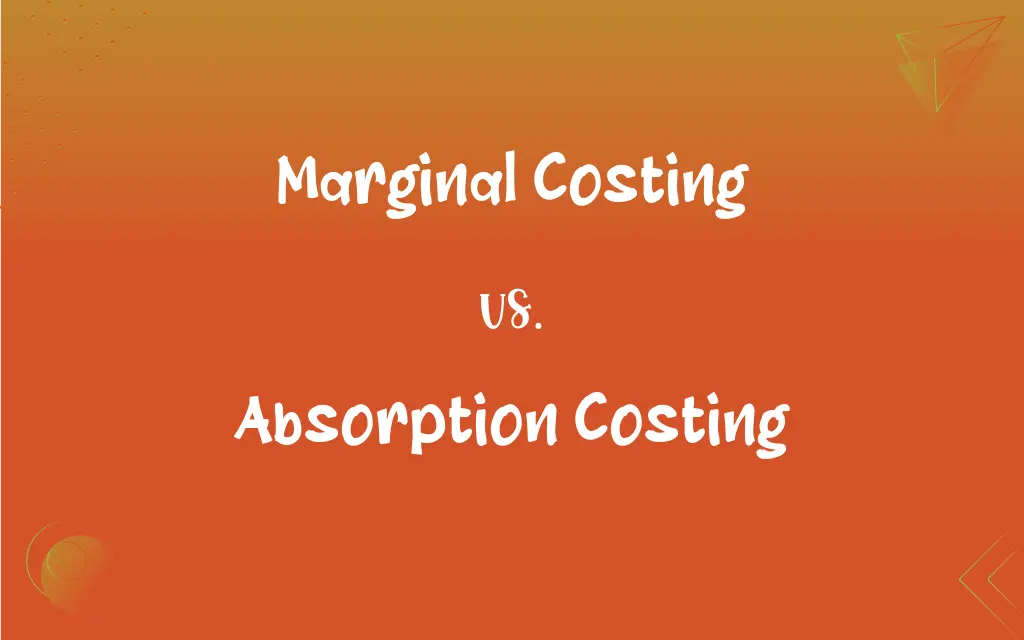Marginal Costing vs. Absorption Costing: What's the Difference?
Edited by Janet White || By Harlon Moss || Updated on October 12, 2023
Marginal costing involves considering only variable costs as product costs, while absorption costing considers both variable and fixed costs.

Key Differences
Marginal costing, distinct from absorption costing, involves attributing only variable costs to production and inventory. Absorption costing, in contrast, considers all production costs, both variable and fixed, when valuing inventory and calculating profit. These different approaches lead to variations in reporting financial metrics and have different implications for financial management and decision-making.
Marginal costing places a distinctive emphasis on the contribution margin, which represents the marginal profit per unit sale. This contrasts sharply with absorption costing, where fixed manufacturing overheads are absorbed into the cost of producing each unit, ensuring that all production costs are apportioned to each unit produced, affecting the per-unit cost.
Marginal costing typically assists in short-term decision-making processes due to its focus on variable costs and the contribution margin. Absorption costing, however, is often employed in scenarios requiring adherence to external financial reporting and taxation regulations, given that it allocates all costs to production.
Marginal costing might yield profit level variations when production levels fluctuate, despite constant sales. In absorption costing, profit is not usually impacted by changes in production levels (assuming constant sales), providing a level of stability in reported profits, as the total fixed overheads are spread over the number of units produced.
Marginal costing is often adopted for its management accounting benefits and its utility in optimizing production decisions under certain conditions. Alternatively, absorption costing is commonly used to prepare financial accounts, as it ensures that all relevant production costs are accounted for in the valuation of inventory, aligning with numerous financial reporting standards.
ADVERTISEMENT
Comparison Chart
Inclusion of Costs
Considers only variable costs.
Includes both variable and fixed costs.
Profit Calculation
Profit fluctuates with sales.
Profit remains stable with constant sales, varies with production.
Pricing Strategy
Often used for competitive pricing and maximizing volume.
May lead to higher pricing due to the inclusion of fixed costs.
External Reporting
Not widely accepted for external reporting.
Commonly used for external financial reporting.
Decision-making
Useful for short-term decision-making.
Considered less suitable for internal managerial decisions.
ADVERTISEMENT
Marginal Costing and Absorption Costing Definitions
Marginal Costing
Marginal costing is the accounting practice of considering only variable costs when calculating the cost of production.
Marginal costing enabled the firm to analyze how variable cost changes would impact the unit cost of their product.
Absorption Costing
Absorption costing assigns all manufacturing costs, both variable and fixed, to products and inventory.
By utilizing absorption costing, the company ensured that each unit produced carried a portion of the fixed overheads.
Marginal Costing
Marginal costing can provide insights for pricing strategies, particularly when looking to maximize sales volume without considering fixed costs.
Employing marginal costing, the business implemented a pricing strategy that maximized sales volume while covering variable costs, despite not factoring in fixed costs.
Absorption Costing
Absorption costing adheres to various accounting standards, ensuring all production costs are attributed to output.
The accountant selected absorption costing to ensure compliance with generally accepted accounting principles (GAAP) in the financial statements.
Marginal Costing
Marginal costing is typically utilized for internal decision-making due to its emphasis on variable costs and contribution margin.
Using marginal costing, the company could swiftly adapt production schedules to optimize for items with higher contribution margins during peak seasons.
Absorption Costing
Absorption costing includes both direct and indirect costs in product pricing, offering a comprehensive pricing strategy.
The business used absorption costing to determine product prices, ensuring full coverage of all production expenses.
Marginal Costing
Marginal costing emphasizes the contribution margin, which assesses the profitability for individual items.
By focusing on marginal costing, managers could quickly assess the profitability of each product line through its contribution margin.
Absorption Costing
Absorption costing can lead to higher reported profit levels when production exceeds sales.
Through absorption costing, the excess production positively influenced reported profits by distributing fixed overheads across more units.
Marginal Costing
Marginal costing treats fixed costs as period costs, charging them in full against the period’s revenue.
Under marginal costing, the monthly rent for the factory, a fixed cost, was deducted directly from this month’s revenue.
Absorption Costing
Absorption costing is commonly used in external reporting and for inventory valuation.
The firm adopted absorption costing for its ability to align with external reporting requirements and accurate inventory valuation.
FAQs
How does marginal costing affect profit reporting?
It may cause profit levels to vary with changes in production and sales volumes.
What is marginal costing?
Marginal costing is a costing method that includes only variable costs in product costs and treats fixed costs as period costs.
What is absorption costing?
Absorption costing allocates all production costs, both variable and fixed, to products and inventory.
Can absorption costing be utilized for management decision-making?
Yes, though its application is typically more useful for external reporting.
How does increasing production affect profits in absorption costing?
Increasing production typically inflates profits in absorption costing, assuming sales remain constant.
Is absorption costing useful for evaluating product profitability?
It can be, though its inclusion of fixed costs can sometimes obscure per-product profitability assessments.
Is marginal costing suitable for external reporting?
Generally, it's not preferred for external reporting due to its exclusion of fixed costs from inventory valuation.
Which costing method shows higher profits when sales equal production?
Both methods show the same profit when sales equal production.
Which costing method is most applicable to break-even analysis?
Marginal costing is often preferred for break-even analysis due to its focus on variable costs.
How are fixed overheads treated in marginal costing during periods of underproduction?
They are fully expensed in the period incurred, potentially lowering reported profits.
In what scenarios is marginal costing most utilized?
It's often used in internal decision-making and evaluating product profitability.
How does marginal costing impact pricing strategies?
It might lead to more competitive pricing by focusing on covering variable costs.
How does absorption costing affect pricing?
It may result in higher product prices due to the inclusion of fixed overheads in cost.
Can absorption costing be used for internal managerial decisions?
While possible, it's often less preferred for internal decisions compared to marginal costing.
What is the primary focus of marginal costing?
It focuses on variable costs and the contribution margin.
How does absorption costing influence profit levels?
Profit is less sensitive to changes in sales volume but can fluctuate with production changes.
How does absorption costing handle fixed manufacturing costs?
It spreads them across all produced units.
Why might a manager prefer marginal costing for decision-making?
Its focus on variable costs and contribution margin allows for agile decision-making.
In which costing method are fixed costs treated as period costs?
In marginal costing, fixed costs are treated as period costs.
Is absorption costing compliant with external reporting standards?
Yes, it is widely accepted for external reporting and adheres to many accounting standards.
About Author
Written by
Harlon MossHarlon is a seasoned quality moderator and accomplished content writer for Difference Wiki. An alumnus of the prestigious University of California, he earned his degree in Computer Science. Leveraging his academic background, Harlon brings a meticulous and informed perspective to his work, ensuring content accuracy and excellence.
Edited by
Janet WhiteJanet White has been an esteemed writer and blogger for Difference Wiki. Holding a Master's degree in Science and Medical Journalism from the prestigious Boston University, she has consistently demonstrated her expertise and passion for her field. When she's not immersed in her work, Janet relishes her time exercising, delving into a good book, and cherishing moments with friends and family.































































